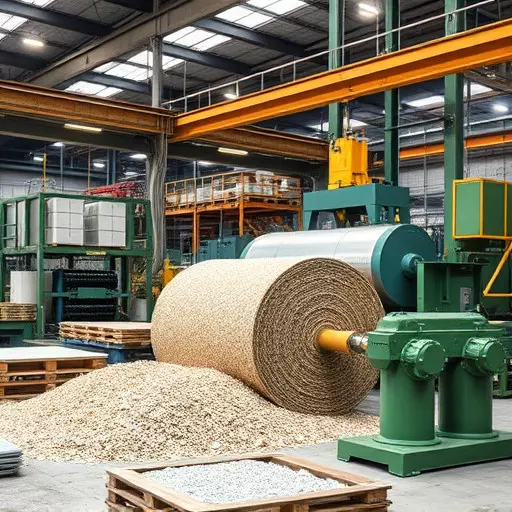Green procurement and eco-friendly manufacturing in Toledo are driving a strategic shift towards sustainability. By adopting circular economy practices, local businesses minimize environmental impact, reduce waste, and foster innovation. Sustainable material processing is transforming traditional procurement, positioning Toledo as a leader in green industrialization. Following five key steps—assess processes, define sustainable criteria, source local products, design with lifecycle thinking, optimize logistics—businesses can contribute to a leaner, more sustainable supply chain while appealing to eco-conscious consumers and partners.
“In today’s digital era, businesses are increasingly recognizing the importance of green procurement practices for a sustainable future. This comprehensive guide explores the shifting landscape of sustainability and its impact on various industries. From understanding the fundamentals of ‘green procurement’ to delving into ‘sustainable material processing’ in Toledo, we uncover strategies like ‘eco-friendly manufacturing’ and introduce the transformative concept of the ‘circular economy’. By following a step-by-step guide, organizations can embark on their journey towards environmentally responsible sourcing.”
- Understanding Green Procurement: A Shift Towards Sustainability
- The Role of Sustainable Material Processing in Toledo
- Eco-Friendly Manufacturing: Strategies and Benefits
- Embracing the Circular Economy: A New Paradigm for Business
- Implementing Green Procurement Practices: A Step-by-Step Guide
Understanding Green Procurement: A Shift Towards Sustainability
Green procurement represents a significant shift in the way businesses approach purchasing and sourcing materials. It’s more than just an environmental consideration; it’s a strategic move towards sustainability. This involves actively seeking out eco-friendly manufacturing practices, from the extraction of raw materials to the final production process. Businesses are increasingly recognizing the importance of sustainable material processing in Toledo and beyond, as part of a broader trend towards a circular economy.
By adopting green procurement practices, companies can minimize their environmental footprint, reduce waste, and foster innovation. The circular economy model encourages the reuse and recycling of materials, thereby decreasing demand for new resource extraction. This not only benefits the environment but also offers economic advantages by reducing costs associated with raw material procurement and promoting a more resilient and responsible business model.
The Role of Sustainable Material Processing in Toledo
In Toledo, the concept of sustainable material processing is revolutionizing traditional procurement practices. This city has emerged as a leader in eco-friendly manufacturing, showcasing how businesses can thrive while minimizing their environmental footprint. By adopting green procurement strategies, local companies are transitioning to more sustainable practices, such as utilizing recycled materials and implementing efficient production methods. These initiatives contribute to the broader goal of fostering a circular economy, where resources are maintained and reused within the city’s industrial landscape.
The integration of sustainable material processing in Toledo’s manufacturing sector offers numerous benefits. It not only reduces waste but also encourages innovation, leading to more environmentally conscious product design. Moreover, it fosters local economic growth by creating demand for eco-friendly materials and technologies, positioning Toledo as a model for sustainable industrialization within the global context.
Eco-Friendly Manufacturing: Strategies and Benefits
Eco-friendly manufacturing involves adopting practices that minimize environmental impact throughout the production process. This includes utilizing sustainable material processing in Toledo and embracing a circular economy model. By focusing on eco-friendly strategies, businesses can reduce waste, conserve natural resources, and lower carbon emissions. One key approach is switching to renewable energy sources for power and heat, which diminishes reliance on fossil fuels.
Additionally, implementing efficient resource management techniques allows manufacturers to maximize output while minimizing input. This could involve recycling and reusing materials within the production cycle, reducing water consumption, and adopting innovative technologies that promote a more sustainable manufacturing ecosystem. These efforts not only benefit the environment but can also drive cost savings and enhance a company’s reputation in the market by appealing to environmentally conscious consumers and partners.
Embracing the Circular Economy: A New Paradigm for Business
In recent years, embracing the circular economy has emerged as a transformative paradigm for businesses aiming to incorporate green procurement practices. Traditional linear models of production and consumption have been replaced by a more sustainable approach that emphasizes recycling, reuse, and regeneration. This shift is not just an environmental imperative but also a strategic business decision, offering significant cost savings and competitive advantages. By adopting eco-friendly manufacturing processes, companies can reduce their reliance on finite resources, minimize waste generation, and contribute to a greener planet.
The concept of sustainable material processing in Toledo, Ohio, for instance, has gained traction as businesses seek innovative ways to incorporate circular economy principles. Local manufacturers are exploring new methods to reuse and recycle materials, ensuring that products at the end of their life cycle can be transformed into valuable resources again. This approach aligns with global trends, where consumers increasingly demand eco-friendly options, and governments implement policies to support sustainable practices. Ultimately, embracing the circular economy is not just a trend but a necessary step towards a more resilient and sustainable future for both businesses and the planet.
Implementing Green Procurement Practices: A Step-by-Step Guide
Implementing Green Procurement Practices: A Transformative Journey
The transition to eco-friendly manufacturing and sustainable material processing in Toledo is a step towards embracing a circular economy, where resources are used efficiently and waste is minimized. Here’s a simplified guide for businesses aiming to integrate green procurement practices:
1. Assess Current Processes: Begin by evaluating your current sourcing and procurement strategies. Identify areas where environmental impacts can be reduced, such as material selection, packaging, or transportation methods. Understanding the existing landscape will help tailor sustainable solutions.
2. Define Sustainability Criteria: Establish clear eco-friendly criteria for vendor selection. Consider factors like energy efficiency, renewable resource use, carbon footprint reduction, and responsible waste management. Collaborate with suppliers to ensure they align with these standards, fostering partnerships that drive collective sustainability goals.
3. Source Local, Sustainable Products: Prioritize locally sourced materials and products whenever possible. This reduces transportation-related emissions and supports regional eco-friendly manufacturing hubs. Engage with suppliers who utilize sustainable practices, ensuring a supply chain dedicated to minimizing environmental impact.
4. Implement Lifecycle Thinking: Adopt a holistic approach by considering the entire lifecycle of products. Encourage suppliers to design items with recyclability and reusability in mind, reducing waste at end-of-life. This aligns with the circular economy model, fostering innovation in eco-conscious product development.
5. Optimize Logistics: Optimize delivery routes and packaging to reduce transportation emissions. Implement efficient inventory management systems to cut down on overproduction and minimize excess waste. These practices contribute to a leaner, more sustainable supply chain.


